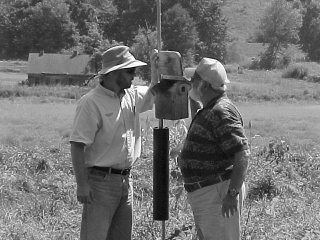When farm operator Virgil Brengarth first made contact with the Missouri Department of Conservation in 1998 to request farm planning assistance for a property he managed, he didn't realize the relationship that would develop.
Brengarth wanted to enter the approximately 400-acre farm in Cooper County that he operated for two Columbia area men - Tom Smith and John Thompson - into USDA's Environmental Quality Incentives Program (EQIP) and the Wildlife Habitat Incentives Program (WHIP). He contacted Reggie Bennett, MDC area biologist. Soon a management plan for the farm was developed and ranked to determine if it would be eligible for the programs. Once approved in 1998, conservation practices were implemented on the property, some with cost-share, some without.
Brengarth continued to call upon MDC for assistance as he implemented the plans. With a substantial portion of the forest cover on hillsides adjoining farmed bottoms, there were black walnut trees on the lower slopes in need of management. Fred Crouse, consulting forester and Mark McCulloch, resource forester, worked with MDC's Private Land Services, to mark a 20-acre parcel for walnut pruning and release.
Three small wetlands were developed. Five ponds/small lakes were built - three of them between 1 acre to 2 1/2 acres in size - and stocked with fish.
Several other open-land management practices were installed with help from
Phil Rockers, private land conservationist. These included two glade restoration projects, reduction of woody cover and prescribed fire. Brengarth and the owners were delighted to report that "three or four native warm season grasses were rejuvenated along with a half dozen or more wildflowers and forbs." A prescribed burn on over 100 acres of fescue pasture was also implemented to reduce litter and make the site more suitable to the establishment of legumes in the cool season grass to increase its benefit to both wildlife and livestock.
Besides wetland construction, landowners Thompson and Smith have built and installed numerous wood duck boxes in the riparian areas of the farm. The owners have an interest in migratory songbirds as well and have built and installed over 200 bluebird nesting houses. MDC's Woodworking for Wildlife plans were used to construct the boxes.
This spring, Terry Gordon, resource forester, coordinated a CRP tree planting project comprised of 88 acres and 37,800 trees. The plantation was installed in a field that was almost entirely sinkholes in a karst topography. Most recently, Brengarth has been working with Robin Tillitt, MDC fisheries biologist, on stream stabilization projects on the farm. Another CRP tree planting project will establish or expand the riparian forest along a 1 1/2 mile stream frontage. A 100-foot cedar tree revetment will be installed, as will a reinforced stream crossing.

Resource Forester Terry Gordon (left) consults with Virgil Brengarth (right), farm manager, about a CRP tree planting project in a field full of sinkholes.